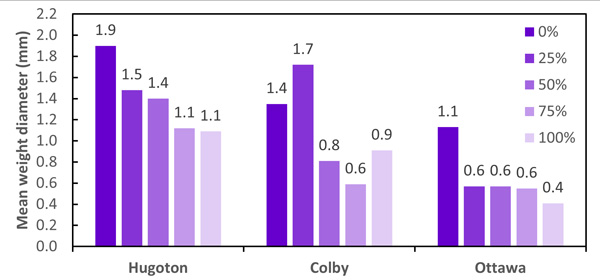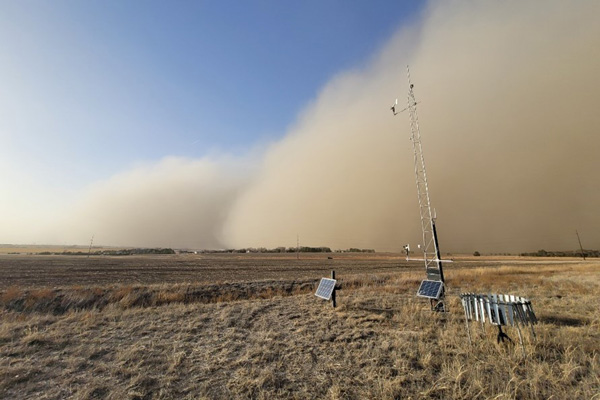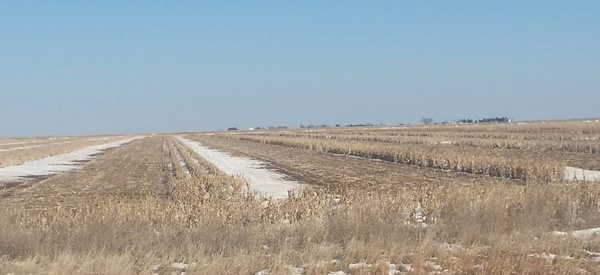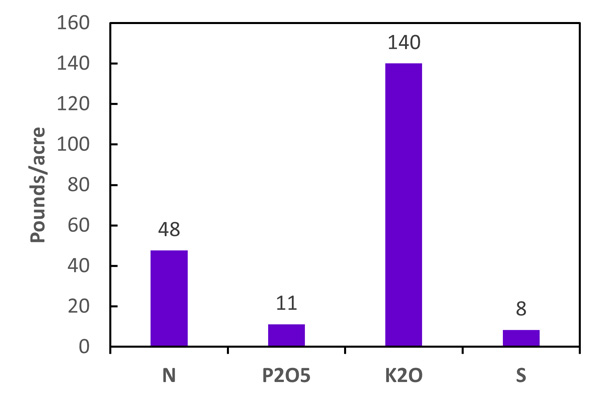About 5.5 million acres of corn and 9,800,000 tons of corn residue (stover) are produced yearly in Kansas (Figure 1). Producers might think about baling some of that stover for animal feed or bedding material at feedlots and dairies or as a bioenergy feedstock for lignocellulosic ethanol. Although baling crop residues provides additional income, producers should consider the potential impacts that residue removal may have on soil and crop health as well as long-term sustainability.

Figure 1. Estimated tons of corn residue produced per year for each Kansas county. Averages from 1999 to 2010 were calculated from crop yields and harvest index from the National Agricultural Statistics Service.
Baling corn residue limits the services that crop residues provide in cropping systems such as conserving soil moisture, protecting from soil erosion, and cycling nutrients.
Soil moisture conservation
Maintaining crop residues on the soil surface enhances soil water storage by increasing infiltration of natural rainfall and irrigation and reducing evaporation with lower soil temperature and reduced wind speed at the soil surface. Crop residue limits the impact of water droplets on the soil surface, which could lead to surface sealing, water ponding, and runoff. Crop residues also block the sun’s solar radiation from directly reaching the soil, which keeps the surface cooler. Researchers from Kansas State University measured soil temperature at Hugoton, Colby, and Ottawa in the 2010-2011 seasons. Removing 50 to 100% of the corn residue increased summer soil temperatures but decreased winter soil temperature. Generally, soil temperatures tended to fluctuate more where residue was removed. Removing corn residue reduced surface soil water content by 5 to 8%, especially during the growing season
Soil erosion protection
Soil that is bare of crop residue is more susceptible to wind and water erosion. Crop residues protect the soil from the full impact of water droplets from natural rainfall or irrigation that can cause soil particles to detach and move with runoff. Crop residue also reduces wind speed at the soil surface that can also cause detachment of soil particles. At Hugoton, Colby, and Ottawa, increasing rates of corn residue removal reduced the mean weight diameter of water-stable soil aggregates (Figure 2).

Figure 2. Impact of corn residue removal on mean weight diameter of water stable aggregates near Hugoton, Colby, and Ottawa Kansas in 2012.
Water erosion from croplands increases sedimentation of rivers, lakes, and reservoirs, which threatens aquatic wildlife, increases risks of flooding, and requires high-cost dredging operations for remediation. In addition to water erosion, wind erosion can cause degradation of air quality, which threatens human and animal health alike, especially in individuals with existing respiratory problems. Wind erosion also causes automotive accidents when visibility is reduced during large dust storms (Figure 3) and can damage machinery due to abrasion and clogging as dust accumulates.

Figure 3. Wind erosion event in southwest Kansas. Photo by Jake Thompson, K-State Research and Extension.
Topsoil loss degrades soil productivity, especially in the long term. Most agricultural soils in Kansas have a “T” value (tolerable amount of soil loss) between 4 and 5 tons per acre per year, about equal to a dime's thickness. To prevent water erosion, 30% ground cover or greater may be needed to reduce water erosion to “T” or less, especially in fields without erosion-control structures such as terraces. Although flat stubble is very effective in limiting water erosion, standing stubble is essential for preventing wind erosion. K-State researchers found that wind erosion was effectively prevented when soil was at least 50% covered by crop residue. Even when baling corn stalks, it’s better to leave some standing residue, which helps capture snow and reduce wind erosion (Figure 4).

Figure 4. Field where stalks were baled, but some standing residue was left on the field. Photo by John Holman, K-State Research and Extension.
Nutrient cycling
Crop residue is often considered to be a valuable source of nutrients. Significant amounts of nutrients such as nitrogen, phosphorus, potassium, and sulfur are left in corn residue following harvest (Figure 5), which can be recycled to the soil with residue decomposition. With the rise in price for nitrogen and other fertilizers, the nutrients in crop residues that could be plant available in the future is worth more than in years past.

Figure 5. Amounts of nitrogen (N), phosphorus (P2O5), potassium (K2O), and sulfur (S) remaining in the residue following the harvest of a 200 bushel/acre corn crop.
Final considerations
Baling corn residues can provide additional income but may negatively impact soil and crop health and long-term sustainability.
- Maintaining crop residues on the soil surface enhances soil water storage by increasing water infiltration and reducing evaporation.
- Crop residue protects the soil from the full impact of water droplets that can cause soil particles to detach and move with runoff.
- Crop residue reduces wind speed at the soil surface, which can also cause detachment of soil particles.
- Significant amounts of nutrients can be recycled into the soil with the decomposition of corn residue following harvest.
- Crop leaves will be blown off the field into ditches and field edges if not baled or grazed.
For more information on considerations before harvesting crop residue, see the publications:
Crop Residues: Abundance and Considerations for Alternative Uses from the KSRE Bookstore
Soil and Crop Response to Stover Removal from Rainfed and Irrigated Corn from Global Change Biology Bioenergy
Wind Erosion Potential from Stover Harvest in the Central Plains: Measurements and Simulations from Soil & Tillage Research.
Logan Simon, Southwest Area Agronomy
lsimon@ksu.edu
DeAnn Presley, Soil Management Specialist
deann@ksu.edu
Tina Sullivan, Northeast Area Agronomist
tsullivan@ksu.edu
John Holman, Cropping Systems Agronomist
jholman@ksu.edu